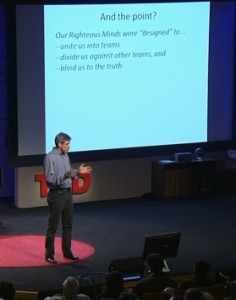 “If you want the truth to stand clear before you, never be for or against. The strugge between ‘for’ and ‘against’ is the mind’s worst disease.” —Sent-ts’an, c. 700 C.E.
“If you want the truth to stand clear before you, never be for or against. The strugge between ‘for’ and ‘against’ is the mind’s worst disease.” —Sent-ts’an, c. 700 C.E.
Who is your target audience?
The first question you need to ask before starting a communications project can come down to analyzing one key motivator for your target audience.
Values.
Before you can unite an idea with an emotion to inspire action, you have to understand why your target audience might not do or think what you think they should. But figuring out why otherwise intelligent and caring people might not think like you is often easier said than done.
The TED talk in the video below provides an excellent starting point for understanding and appealing to people’s moral intuitions. Drawing on ethnography, evolutionary theory, and experimental psychology, the speaker, psychologist and professor Jonathan Haidt, explains how five fundamental ideas commonly undergird moral systems around the world: harm/care, fairness/reciprocity, ingroup/loyalty, authority/respect, and purity/sanctity. He further explains how people’s minds are designed to unite us into teams according to these fundamental ideas, divide us against other teams, and blind us to what’s happening.
Haidt’s research shows liberals worldwide value justice, change, and freedom from oppression—even at the risk of chaos. Conservatives, meanwhile, value preserving tradition and legitimate fidelity to rules that have stood the test of time—even at the cost to those at the bottom. Because these are often opposing moral visions, Haidt’s talk is a reminder that messages framed without audience research and an understanding of communications theory could inadvertently repel half your audience.
I predict Dr. Haidt’s theory will become a communications theory classic like professor Geert Hofstede’s national cultural dimensions theory, anthropologist Edward T. Hall’s high- and low-context culture theory, SRI International’s VALS (“Values, Attitudes And Lifestyles”) framework, and professor Everett Rogers’s diffusion of innovations theory among others. These theories show how complex human behavior and decision-making is, and reading them reminds you the more you know, the more you know you don’t know.
That leads you back to a common theme of this blog: the need for audience research (perhaps combined with a knowledge management approach) when your objective is behavior change.